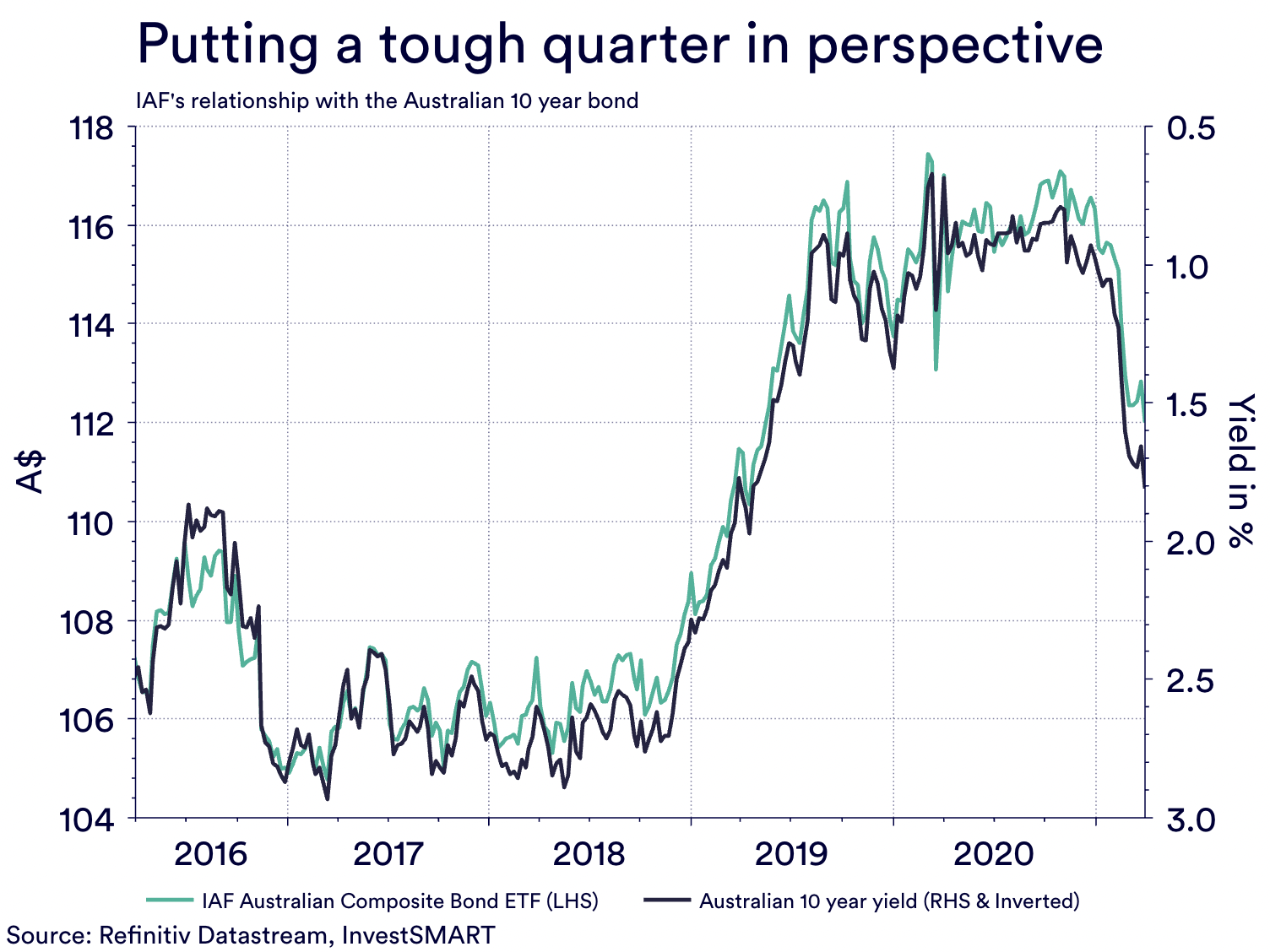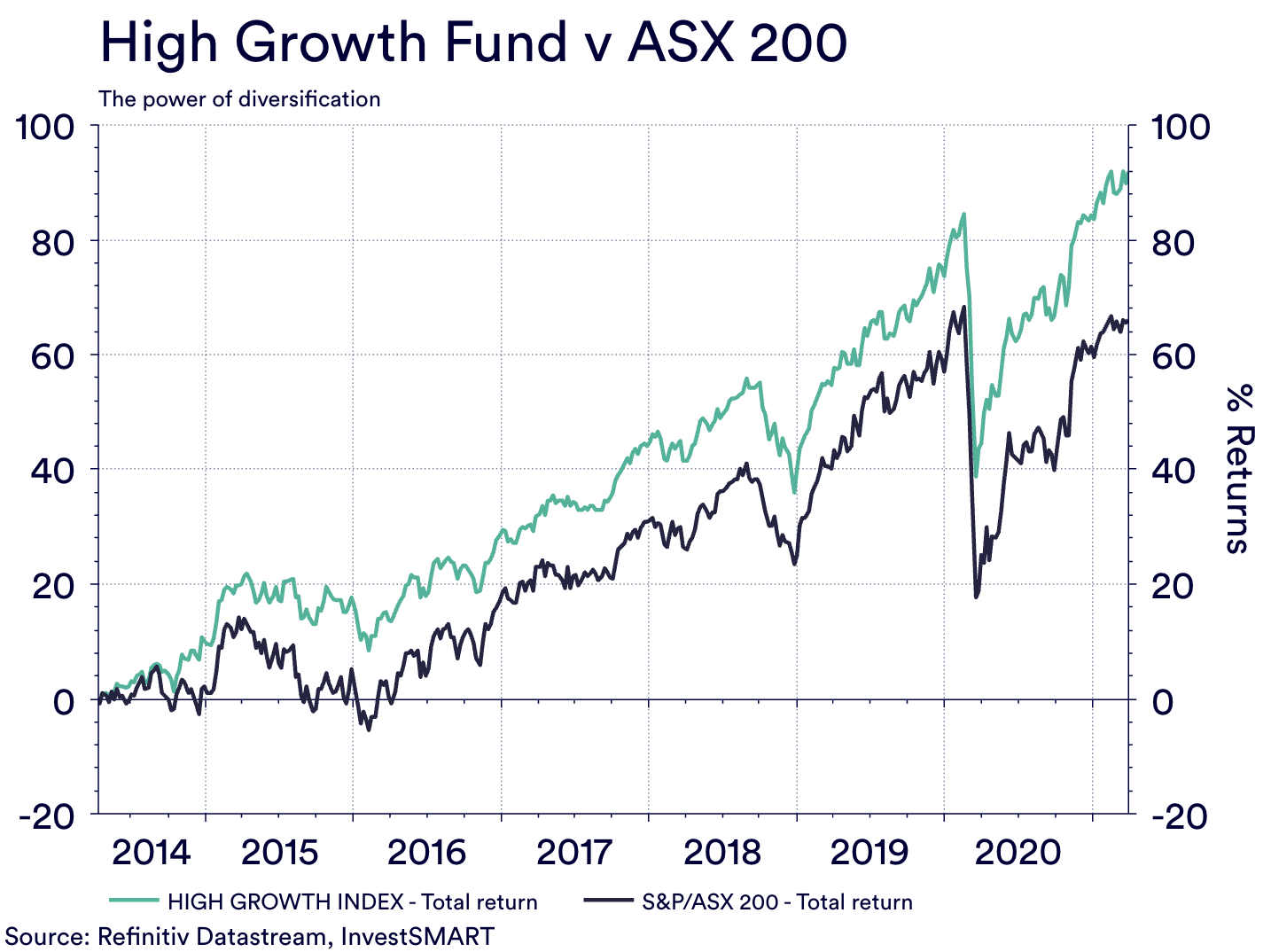InvestSMART's High Growth Portfolio: March Quarter Review 2021
- The portfolio appreciated 4.11 per cent after fees in the March quarter.
- No changes were made to the portfolio during the quarter.
- The yield on the portfolio is approximately 2.31 per cent.
- Since inception the portfolio has averaged 8.54 per cent after fees.
It was a solid quarter for the High Growth Portfolio with the international equities side doing a significant part of the heavy lifting.
It was an uneven quarter we must say and the best summary of why the High Growth Portfolio lost some ground compared to its single asset peers can be seen in this chart from Bespoke Investment Group.

This chart shows just how big a divergence there was in the first quarter between US bonds and the S&P 500. The 18 per cent difference is the largest divergence in 40 years, the fall in long dated bonds (those bonds with a duration of 10 years or more) was a record first quarter decline. The key take out from the divergences across the portfolio in the first quarter was that it was abnormal and the probability of it happening again in the near future is very low.
We should also put this into the perspective of your risk profile and your investment time horizon. The High Growth Portfolio is significantly weighted more towards risk assets such as domestic and international equities and property. In fact, near enough to 90 per cent of the High Growth Portfolio is geared to growth but that does not mean we forgo the need for defensive assets as history shows that fixed income and cash are vital for sustained, buffer-protected returns, even in a high growth profile.
We stress the following point – fixed income is one of the core asset classes of any investment portfolio, even those with a high risk tolerance. It provides a strong and solid foundation; its income component provides a consistent long-term income rate, and the capital component is majority backed by sovereign governments or tier-1 corporations.
Yes, like any floating market, it can be subject to short bouts of volatility. Its normal advantage is that these bouts of volatility are mild in comparison to its riskier peers such as equities and property but that’s not always so.
In the High Growth Portfolio, we hold the iShares Australian Fixed Income ETF (IAF) for your Australian treasuries’ exposure. Its biggest holding is the Australian government 10-year bond and as this chart shows very clearly, the Australian 10-year bond was sold off in the quarter causing its yield to rise which saw IAF’s sell off mirroring that of the 10-year.

This fall has led to a debate over the merit of fixed income, with some even suggesting it’s facing an ‘existential crisis’ and that it no longer has a place for investors. This is disingenuous, as the same chart above shows the incredible positive movement throughout 2019. We even warned investors back then that that kind of appreciation was abnormal in the fixed income sphere and not to expect this kind of move on a long-term basis.
We are here to remind you of the same point but in reverse – fixed income will return. If we look at the Australian 10-year bond, its price is currently below its ‘face value’ (for more on the inner workings of fixed income, click here to view our fixed income series)
Furthermore, the performance of the High Growth Portfolio during this period needs to be looked at in the context of risk and your tolerance of risk. It also needs to be looked at in terms of your investment time horizon.
As a high growth investor, you should be looking to invest for 7 years or more. Therefore, if we compare the ASX 200 to the Australian High Growth Index over time, the last quarter’s slightly lower performance to single assets like the ASX 200 is put into perfect perspective as this chart shows.

The chart also highlights the advantage of diversification over single asset classes. High growth has not only weathered the COVID-crisis better, but also the selloff in global markets in October 2018 and the declines seen in 2015. The portfolio is designed to take full advantage of what all growth markets can bring to your total returns, which has helped it outperform.
Investors should continue to apply their personal risk tolerance to their investment goals and should remember that overall long-term performance is core to reaching these goals.
Frequently Asked Questions about this Article…
The High Growth Portfolio appreciated by 4.11% after fees in the March quarter, with international equities playing a significant role in this performance.
The yield on the High Growth Portfolio is approximately 2.31%.
The High Growth Portfolio lost some ground due to an abnormal divergence between US bonds and the S&P 500, which was the largest in 40 years. This divergence is unlikely to happen again soon.
Fixed income is crucial even in a high growth portfolio as it provides a solid foundation and consistent long-term income, despite occasional volatility. It acts as a buffer against riskier assets like equities and property.
Despite recent debates, fixed income is not facing an existential crisis. Historical data shows that fixed income can experience positive movements, and its role in providing stability remains vital.
High growth investors should aim for an investment time horizon of 7 years or more to fully benefit from the portfolio's potential returns.
Diversification allows the High Growth Portfolio to weather market downturns better than single asset classes, as seen during the COVID-crisis and other market declines.
Investors should consider their personal risk tolerance and investment goals, focusing on long-term performance to achieve their financial objectives.
















